Name Two Artists That Brought Stop-action Animation Into Its Own?
Agreement the Fine art of Stop Motion
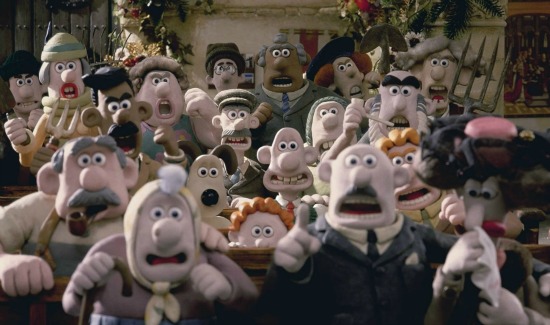
Finish motion: the art of bringing inanimate objects to life. While some filmmakers might observe this style of blitheness tedious, there are those that appreciate and treat it as an fine art grade. In that location is something magical about physically touching the objects to immerse oneself into one'south work, and stop move is slowly gaining recognition for its peculiar style. Its origins trace back to the tardily 1800s, to a fourth dimension when 'movie magic' helped viewers believe that the objects were moving on their ain. Unfortunately, compared to Calculator Graphic Images (CGI), finish motion may no longer seem impressive to viewers, equally its choppy movements tin be considered likewise 'retro' for the audience.
Still, technology has advanced to improve this process, thus stop motion can no longer be considered 'out-dated' compared to its competitors. This article will explore how cease motion has become popular by looking at its history, and analyze how other studios are currently using it. Although it is always compared to other blitheness styles, such as CGI, stop motion has its own charm that has led filmmakers to choose this medium for stylistic reasons, as stop motility is able to present a 'handcrafted' feel to the audience.
Stop Move: A Brief History
What gives end motion that 'handcrafted' feel is the fact that information technology is the art of object manipulation, as the object is moved in small increments between individual photographed frames. This creates the illusion that the object is moving, and there are many forms of stop motility to requite this animation mode its own genre. At that place is claymation (or clay animation), the almost common grade of terminate movement, in which dirt models are created around a wired skeleton to be used as subjects. At that place is also time-lapse animation, in which unmarried frames are taken at periodic intervals (ex: to make the weather modify in the class of a twenty-four hour period), boob animation, and pixilation, which has human subjects move from frame to frame. ane With such a rich history, it would be impossible to make this cursory history lesson 'cursory' considering of stop movement's vast timeline. Thus, this article volition focus on the pioneers of this art form and a few American artists that are well-known in history.
The first utilize of cease motion animation was in 1898 when Albert E. Smith and J. Stuart Blackton madeThe Humpty Dumpty Circususing object blitheness. The premise was simple – motility the objects to make the toy circus come to life. Following this notion was Thomas A. Edison'sFun in a Bakery Shop, which was directed in 1902 by Edwin S. Porter (the video below).Fun in a Bakery Shopused a mix of object animation and terminate-action photography, which involves pausing and changing something in the shot before resuming the motion picture. In this particular brusk, the baker stops his motions to appear to exist instantaneously making all of the faces out of dough. 2 These techniques fabricated stop motion like shooting fish in a barrel to make, and it took America 31 years afterwards to discover information technology every bit an art form thanks to Willis O'Brien.
Fun In A Baker Shop- Early Finish Motility Animation
Willis O'Brien was gifted in the creation of cease move creatures and is known for his visual effects in the motion-picture showRex Kong (1933). The film'southward success was dependent on O'Brien's realistic creatures, as he focused on King Kong and the dinosaurs. He was obsessed with details and based his dinosaur models on precise paleontological studies. He also created a King Kong that was not just a model but besides a graphic symbol. 3 O'Brien did this by using total armature skeletons and putting rubber skin and fur over the models, creating the iconic finish-motion shots of King Kong atop the Empire State Building iv (which can exist viewed below).
Kong climbs The Empire Land Building ( King Kong 1933 )
O'Brien'south work inspired his protégé, Ray Harryhausen, to behave on the piece of work, as he further composite the stop motion model with live action footage. Harryhausen is well-known in terminate motility'due south history, as he created creatures for films such asJason and the Argonauts, 1 Million Years, and Clash of the Titans. Following the release of the 1981 release ofDisharmonism of Titans, special effects evolved to apply computer graphics and diminished the fine art. Nonetheless, finish motion's animation still appealed to many artists, which led to its revival decades later on thank you to the release of TheNightmare Before Christmas (1993).
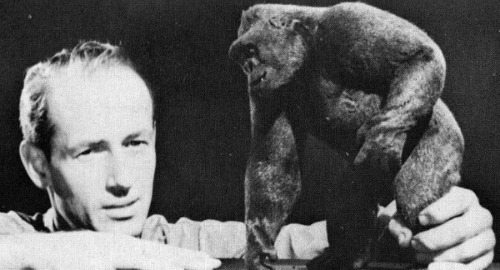
Popularizing the Art Form
In that location are many artists that popularized the fine art form in their storytelling. End movement is maybe chosen because of preference, only fans believe that the appeal of terminate motion lies in its magical qualities, as stop motion animators are able to transform the ordinary – similar to how children utilise imagination to transform their toys five. In particular, in that location are a few filmmakers that are well-known for their finish motion films, which will be explored in the section below.
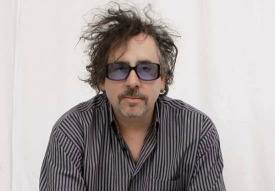
Tim Burton
The about influential stop-motion artist is Tim Burton, as his film, TheNightmare Earlier Christmas, was the commencement film to be made entirely with stop move techniques. Previously, cease motion was used for shorts and special effects, and was designed to only concur the audience's attending for a brief moment 6. This was because stop move was and nevertheless is time consuming, thus involving the audition on an emotional level for 90 to 120 minutes was an arduous task. Still, Burton was able to achieve commercial success with The Nightmare Before Christmas, and he built upon his success with other films such asJames and the Behemothic Peach (1996), Corpse Helpmate (2005) and Frankenweenie (2012). As for Burton'southward determination on why he chose stop motion, he states, "There'due south an free energy with stop-motion that you can't even draw. It's got to do with giving things life." 7
Henry Selick
Although Burton'southward name is associated with TheNightmare Before Christmas, many are non aware that the managing director that brought the movie to life was none other than Henry Selick. Before working onThe Nightmare Before Christmas, Selick worked on his own projects, and one that became a critical success was Seepage. ForSeepage, Selick mixed end motion and water colour animation to tell the story of 2 people talking while sitting almost a pool 8. He then worked with Disney, and worked on films such as Pete's Dragon (1977)andThe Trick and the Hound (1981). In his colorlessness and apprehension to search for his side by side picture show, he plantThe Nightmare Before Christmas,and was excited to work with his one-time classmate Burton.
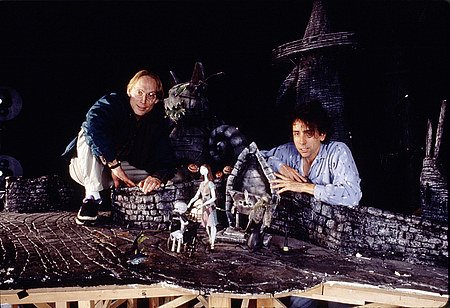
While Burton handled the artistic decisions, Selick decided to push button the boundaries of finish motion. It was a painstaking procedure, equally each model had to be created and constantly retouched. This resulted in the film to be in production for two years until information technology was released. In his review of the picture, Roger Ebert, a well-known movie critic, said:
Simply the director of the film, a veteran stop-activity master named Henry Selick, is the person who has made it all work. And his accomplishment is enormous. Working with gifted artists and designers, he has fabricated a globe here that is as completely new as the worlds we saw for the outset time in such films as Metropolis, The Chiffonier of Dr. Caligariand Star Wars 9.
The studio was so proud of the film'due south success that Selick continued to piece of work with Burton and directedJames and the Giant PeachandCoraline. Although Selick'south films are non consequent blockbusters, some consider his films to exist the most interesting and innovative, as they characteristic a number of emotional and technical layers that add together a personal tone to each production 10.
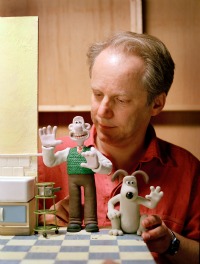
Nick Park
A British animator, Nick Park is known for creating the characters, Wallace and Gromit, and completed his get-go short at Aardman Animation chosenA M Day Out (1985).Park became well-recognized in the industry after winning a British Academy Honor forA Grand Day Out, and he created more than Wallace and Gromit shorts such every bitThe Wrong Trousers, A Close Shave and A Thing of Loaf and Decease. 11 After winning awards for his shorts, Park set his eyes on making characteristic length films, and createdChicken Run(2000) andThe Curse of the Were-Rabbit (2005). He continued to win many awards until an unfortunate incident occurred when a burn down destroyed the Aardman warehouse that stored all the sets and models forChicken Run. 12 Luckily, the Wallace and Gromit models were safe, only there was no hope for a sequel to Chicken Run (although one tin can enjoy the animation for the scene beneath).
Chicken Run - Pie Machine Scene
With so many inspiring cease motion filmmakers, one would recollect that at that place would exist more artists working with this medium. Unfortunately, stop motion does non always do well commercially, thus many filmmakers prefer to work with CGI instead. This makes it off-white to compare the two mediums, every bit there are pros and cons for both styles of animation.
CGI vs. Terminate Movement
Unfortunately, in that location is a large difference when it comes to the profits between cease movement and CGI. The highest gross film for stop move isChicken Runwith an estimate of 225 million 13, which is an impressive feat, as the picture was made on a 42 one thousand thousand upkeep 14. Notwithstanding, the ane.two billion thatFrozen cashed in makes Chicken Run's profits seem like 'chump alter' in comparison, but it is as well worth mentioning that Disney had an excellent marketing strategy, every bit explained in this article.
With the advancement of modern engineering science, techniques for CGI are likewise getting better, equally CGI is not only used to brand animated films but also special furnishings (a more detailed look tin can be seen here). This notion is the same for stop motion, as video assist and capture software enables for a more efficient technique and sophisticated motion. fifteen Therefore… if both mediums are steadily improving, which one is better?
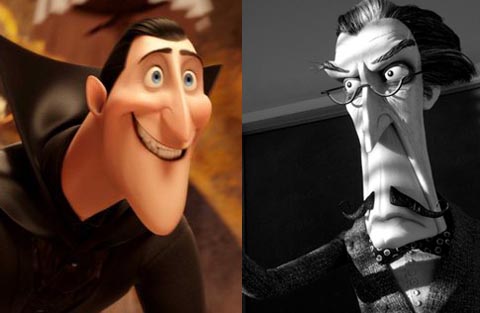
Honestly, deciding between CGI and stop move is similar to asking a painter if they prefer to pigment with acrylics or watercolours – it all depends on preference. Whereas some viewers may be more accustomed to the wait of 3D films (and detect cease motion foreign), there are also those that bask cease motion and appreciate the endeavor it takes to create these masterpieces. Not all viewers care near the blitheness style, as the near of import element in a picture show is to entertain the audition. Therefore, the medium should not exist blamed for a loss in profits, as storytelling is the primary goal for every film that is produced.
Rather than deciding which one is meliorate, why not combine the two styles together? If utilized properly, CGI is able to better stop motion by reducing the blur and increase the smoothness in blitheness. If the 2 styles mix, this will not only bring new life to the art, but also increment the quality of these films. Thus, a matrimony is formed.
The Marriage
There are limitations when it comes to producing stop motion films by hand because of the fourth dimension and effort it takes. Hence, the marriage of CGI and terminate motion not just makes it easier, but as well provide a gateway to create some incredible things. Some might phone call this 'cheating', merely according to the directors ofParaNorman, CGI comes in a pinch when it is not practical to create sure things by manus. Chris Butler, one of the directors, states:
"We're not militant purists almost it. We always think, 'We know what imagery we want to capture and and then we use the all-time method to get it.' Our starting point is always going to be applied; information technology's always going to exist handmade because that's the studio nosotros are. Merely we would never say no to something because you tin can't realize information technology practically. If we need CG to fix this…" 16
The studio Butler refers to is chosen LAIKA Films, an animation studio based in Oregon known for its end motion creations. LAIKA Films has created films such equallyCoraline, ParaNorman andThe Boxtrolls, and has'handcrafted and transformed everyday materials into living creatures infused with dimension and soul'. 17 Still, practicality wins over stop motion traditions (aka building everything by mitt), thus LAIKA films is known for using innovative applied science to help with the process.
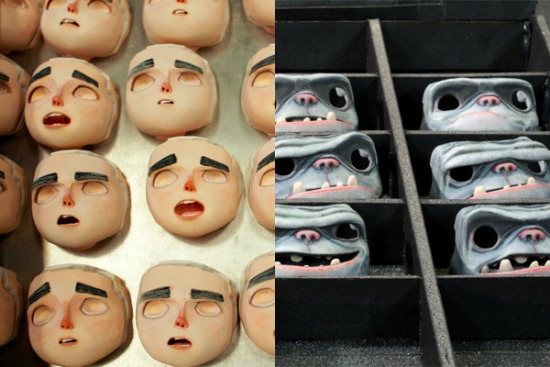
For example, the graphic symbol models forThe Boxtrolls were created with 3D printers. This was essential to the production, as The Boxtrolls had 79 sets and more than 20,000 props to make. Before 3D printing existed, the art department had to individually make each expression by hand. Information technology seems tedious to brand a new face each fourth dimension, just for stop motion, this is part of the process on creating an animated grapheme. In fact, Eggs, the principal character in the film, had 1.four million expressions in full. xviii That's a lot of expressing!
If the people in the past were told to make one.4 1000000 expressions, they would certainly quit on the spot. Thus, 3D printing and other modern tools take made the impossible possible because of the existence of this engineering. Graham Annabele, the director of The Boxtrolls, explains, "It's the subtleties that the printers are capable of, which goes dorsum to the printers themselves but as well the materials that they're putting through them now. The faces have a look kind of like a Lucian Freud portrait or even an Egon Schiele painting where the colour variation is very subtle." 19
LAIKA Films is an example of a studio that takes a classic art class and transforms it using engineering science. The past meets the hereafter in this production process, which demonstrates that stop motility has the ability to make an impact on screen if the correct tools and people work on the projection together.
So what is to be expected for the future of stop move? With the lack of stop motion films beingness produced, many presume that terminate motion is dying and that studios prefer to use CGI for their feature length films. Is it considering CGI performs exceedingly well compared to end motion? Past looking at its history, it can be speculated that the interest for stop move merely fluctuates, and that the interest grows depending on how the filmmaker uses the medium.
The advancement of technology has also helped with stop motion productions, and there is no shame in combining CGI and end movement together. In regards to numbers, it is not e'er the medium'due south fault for a film'south loss of profits. Rather, storytelling is an of import factor for the film's performance, which is why scripts are rewritten several times earlier they are put in production. Although terminate movement can be time consuming, its lengthy process also makes for a skillful joke, as explained in this 'fourth wall breaking' scene fromThe Boxtrolls. Subsequently all, there is nothing scarier than a fictional grapheme questioning their existence and universe.
What do you think? Exit a comment.
Receive our weekly newsletter:
Source: https://the-artifice.com/art-of-stop-motion/
Posted by: rayandoess.blogspot.com

0 Response to "Name Two Artists That Brought Stop-action Animation Into Its Own?"
Post a Comment